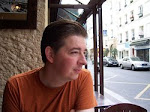On this date in 1928, Cleveland police discovered a convention of U.S. Mafiosi at the Hotel Statler on Euclid Avenue and East 12th Street.
Scores of detectives and uniformed police officers quickly surrounded the hotel and raided rooms occupied by out-of-town visitors with Italian-sounding names. Twenty-three men were arrested as suspicious persons. Eighteen of them were found to be armed. Among the suspects were known crime figures from Chicago, New York, Buffalo, Tampa and St. Louis.
The sole representative of Buffalo was Salvatore "Sam" DiCarlo. The youngest son of western New York's earliest known Mafia boss, at the time Sam DiCarlo was a trusted member of Stefano Magaddino's underworld organization.
 |
| Fourteen of the twenty-three arrested men were photographed by police as a group. Giuseppe Profaci is at center, seated in a wheelchair due to a recent accident. Sam DiCarlo of Buffalo stands behind him. Joseph Magliocco is to the right of DiCarlo. Pasqualino Lolordo of Chicago is seated to the right of Profaci. |
The others arrested on December 5, 1928, were Pasqualino Lolordo, Giuseppe Giunta, Frank Alo, Tony Bella, Emanuele Cammarata, James Intravia, Sam Oliveri and Giuseppe Sacco from Chicago; Giuseppe Profaci, Giuseppe Magliocco, Vincenzo Mangano, Giuseppe Traina, Andrea Lombardino, Salvatore Lombardino, Giuseppe Palermo and Michael Russo from New York and New Jersey; Ignazio Italiano and Giuseppe Vaglica from Tampa; Giovanni Mirabella and Calogero SanFilippo from St. Louis; Paul Palazzola of Gary, Indiana; and Sam Tilocco of Cleveland. (The suspects gave various stories to explain their presence in Cleveland. Officials accepted only the tales told by Mangano and Traina, and those two Mafia leaders were quickly released. The rest were interrogated by police and immigration officials and then arraigned.)
 |
| Portsmouth OH Daily Times, Dec. 5, 1928. |
Police expressed their certainty that other organized criminals were staying elsewhere in the city. Rumors indicated that Chicago's Al Capone had been seen in the area.
Local authorities believed they had broken up a meeting called to settle feuds over Prohibition Era corn sugar, a necessary commodity for moonshining operations. They were mistaken. The bloody corn-sugar wars of the Cleveland underworld already had been resolved.
Some historians have suggested, quite wrongly, that the Cleveland gathering was the first formative convention of the U.S. Mafia (a number of writers have referred to the criminal society as the "Unione Siciliana"). Actually, a national Mafia network had been in place for many years, and meetings of Mafiosi occurred fairly regularly.
 |
| Masseria |
Other explanations have been offered. Some say that the convention was called to reallocate underworld rackets following recent gangland assassinations, to resolve underworld disagreements in Chicago or to recognize the ascension of Profaci to the rank of family boss. However, local or regional issues would not warrant the calling of a national convention. It appears far more likely that the convention's purpose was to recognize the U.S. Mafia's new boss of bosses Giuseppe Masseria.
At war with reigning boss of bosses Salvatore "Toto" D'Aquila since the dawn of the Prohibition Era, Masseria had assembled the strongest and wealthiest crime family in the country. The recent murder of D'Aquila on a Manhattan street left Masseria's appointment as boss of bosses a mere formality. Though Masseria's own home base was in New York City, many of his kin resided in Cleveland, and Masseria allies in Cleveland had recently defeated a pro-D'Aquila faction there. The city would have been an entirely appropriate selection for a Masseria coronation.
Critics of this view note that Masseria and his allies were not among those taken into custody at the Hotel Statler. Of course, with much of his family in the area, there would have been no reason for Masseria to stay at any hotel. And police publicly expressed their disappointment that the hasty raid at the Statler allowed other conventioneers to get away.
Read more about the 1928 Mafia convention in Cleveland and other Cleveland underworld events in:























